There's more to it than the classic Halloween pumpkin. From edible pumpkins for cooking to poisonous ornamental pumpkins - we present all varieties.
Now, when the days are getting shorter again and the trees more colorful, the long-awaited time of pumpkins begins. Of course, most people immediately think of the classic one Halloween pumpkin for carving. The type of Pumpkins (Cucurbita) so much more to offer: Whether orange, green, white or yellow pumpkin, edible like that Butternut- or Hokkaido pumpkin, or decorative pumpkins with bitter substances. In order to keep an overview of all the different types of pumpkin, we have put together an overview for you below. Here you will find the right variety for every purpose - regardless of whether you want to cook a delicious pumpkin soup or set up a carved pumpkin face as a decoration for Halloween.
contents
-
Pumpkin varieties: Edible pumpkins
- Edible pumpkin varieties: Cucurbita moschata
- Edible pumpkin varieties: Lagenaria siceraria
- Edible pumpkin varieties: Cucurbita pepo
- Edible pumpkin varieties: Cucurbita maxima
- Ornamental pumpkin varieties: Poisonous varieties to decorate
- Poisonous pumpkin varieties: varieties with dangerous bitter substances
- Edible varieties of pumpkin: varieties for cooking
Pumpkin varieties: Edible pumpkins
Especially when the year is drawing to a close and autumn is on the rise, some exotic foods that are more likely to belong to summer fall off our menu. But there is no reason for regret: after all, now is the time for the pumpkin. Whether as a delicious pumpkin soup, in a cake or simply as an oven vegetable - pumpkin can be used universally and impresses every hobby cook with its fine taste and beautiful color. Below we present you the best edible pumpkin varieties for cooking.
Edible pumpkin varieties: Cucurbita moschata
This subspecies of the pumpkin family is native to America. In the meantime, however, a variety of different varieties has formed. The colors range from orange, yellow to green.

- Quintals: Very large and round with a slight rib; orange peel with edible pulp; 130-150 days.
- Trumpet by Albenga (also: Tromba d’Albenga): Coiled shape; light green shade; yellow-brown pulp; edible, but more suitable for decoration; 130-150 days to harvest.
- Violina: Italian variety with elongated fruit shape and yellow-brown ribbed skin; aromatic and easy to preserve; 130-150 days to harvest.
- Rugosa Friulana: Early ripening, Italian variety with elongated, yellow and uneven fruits; Type: butternut squash.
- Butternut / Avalon: Large, bell-shaped fruits with pale skin and an intense, sweet-aromatic taste.
- Muscat de Provence: Particularly aromatic pumpkin; has round, deeply ribbed fruits with light orange to brownish skin; the firm flesh is bright orange in color and very tasty; The variety is also characterized by a long shelf life.
- Solor: Very robust variety that has proven itself especially in organic farming; the high carotene content gives fruits and pulp a deep orange color, hence a popular decorative pumpkin; firm and nutty-grainy tasting pulp; Type: Hokkaido.
- Olga: Oil pumpkin variety with a soft, green-yellow skin; the tasty seeds are shellless and contain high quality pumpkin seed oil; the kernels are said to have a healing effect on bladder problems and prostate problems.
- Rocket F1: Pumpkin with handy, round fruits; bright orange color; ideal for decoration; orange-yellow pulp; suitable for canning.
- Big max: Giant pumpkin with hard-skinned, orange fruits; ideal for carving jack o lanterns.
- Atlantic Giant: Giant squash; can achieve record weights (European record 2009 with approx. 650 kilos); light orange fruits; yellow, tasty pulp; good for canning.
tip: In addition to the variety, the supply of nutrients is also an important prerequisite for a rich pumpkin harvest. For strong and resilient pumpkin plants, it is best to use a primarily organic organic fertilizer like ours Plantura organic tomato fertilizer with a three-month long-term effect.
- Early Butter Nut F1: Pumpkin with pale, bell-shaped fruits; sweet and aromatic pulp.
- Sweet Jack F1: Round, deep orange fruits with a dark stalk; tasty pulp.
- Tiana F1: Mini butternut pumpkin variety with pale yellow, bell-shaped fruits; dark, tasty pulp; also very popular as a decoration.
- Honeynut: “Small butternut” with bell-shaped fruits; firm, orange skin increases its field resistance; the orange pulp is extremely sweet in taste; resistant to powdery mildew.
- Futsu Black: Small, flat-round fruits with deep ribs and isolated warts; the skin is initially dark green, later beige with a gray coating; delicious orange pulp.
- Longue De Nice: Club-shaped fruits that can be eaten when they are green; when fully ripe, the skin is colored beige; excellent pulp.
- Serpente Di Sicilia: Italian variety with very elongated fruits and light green skin; yellow, firm pulp; ripe early to medium early.
Edible pumpkin varieties: Lagenaria siceraria
This bottle gourd is one of the oldest cultivated plants in the world and is ideal for eating.
- Hercules Club Snake: unusual climbing plant from southern Italy with up to 2 m long, bottle-shaped fruits; very tasty pulp, can be prepared like cucumber or zucchini.
- Wine lifter Kittenberger: The variety originally comes from Styria; Fruit shaped like a wine lifter; the young fruits are edible; When dried, the fruit can also be used as a vessel or musical instrument.
Edible pumpkin varieties: Cucurbita pepo
The garden pumpkin is one of the most frequently used types of pumpkin and is particularly noticeable for its climbing or crawling growth. In 2005 it was named Medicinal Plant of the Year. The classic Halloween pumpkin for carving also falls into this class.
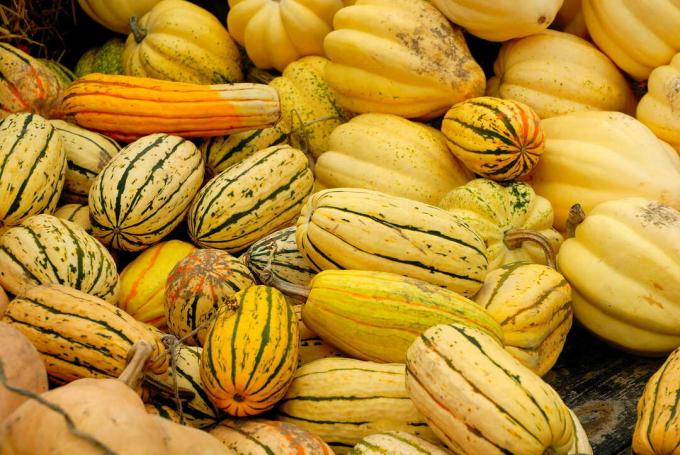
- Pyza (even: Spaghetti squash): Light yellow, oval fruit shape with light yellow pulp that breaks up into individual, spaghetti-like fibers after cooking; high-yielding variety; ideal for greening compost heaps.
- Tiana: Pear-shaped shape and light yellow hue; firm and tasty pulp; resistant to powdery mildew; definitely worth cultivating; Type: butternut squash.
- Vegetable spaghetti: Italian variety; elongated oval fruits with a pale orange color and light pulp.
- Gleisdorf oil pumpkin: Small round pumpkin with yellow skin and irregular green stripes; The nutty-tasting kernels are particularly popular, as they do not have a shell; also used as a prostate remedy.
- Mandarin: Ornamental and edible pumpkin with yellow-orange skin and deep ribs; extremely aromatic pulp; durable.
- Tom Fox: The classic Halloween pumpkin; Fruits grow in different shapes and can weigh up to 8 kg; ideal for carving.
- Spaghetti squash: the garden gourd Vegetable Spaghetti got its name from the fibers that are similar to spaghetti; The skin and pulp are pale yellow in color; ideal for greening compost heaps.
- Baby bear: Perfect mini pumpkin with a rich orange peel; extremely tasty pulp; also suitable for cultivation in pots or on the balcony.
- Microwave Pumpkin SC 415 F1: Deep yellow fruits with orange stripes, very decorative; high food value; After spooning out the seeds, the pumpkin can be cooked in the microwave for 5 minutes and then served.
- Bush Delicata: Bush-shaped growing variety with small, elongated fruits and yellow-green, striped skin; very tasty pumpkin variety.
- Pâtisson Blanc: Flat-round, flower-like fruits with a striking peel in snow-white.
- Rondini: Small, round fruits with dark green skin and yellow pulp.
- Jack O’Lantern: Classic Halloween Pumpkin; ideal for hollowing out; also excellent in taste as a soup.
- Heracles: Round oil pumpkin variety with yellow, ribbed skin and pale green stripes; forms many, shell-less kernels that are suitable for direct consumption or for the production of pumpkin seed oil.
Edible pumpkin varieties: Cucurbita maxima
The subspecies of the giant pumpkin provides the largest fruits in the entire plant kingdom. But not only the decorative value of these giants is remarkable, but also the variety of flavors. This type of pumpkin is also suitable for consumption.
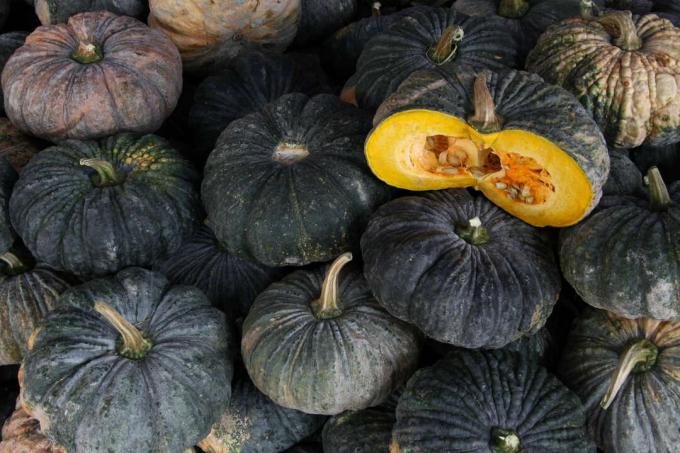
- Green Delicious: Old variety that is preserved and propagated by the Noah's Ark Association; very aromatic, deep yellow pulp; definitely worth cultivating.
- Delica (F1): Early ripening Italian pumpkin variety, with green, round pumpkins; high-yielding, easy to store and tasty.
- Berrettina Piacentina: Italian pumpkin variety with green-gray skin and yellow-orange pulp; early to medium ripe and can be stored for an extremely long time.
- Lunga Di Napoli: Italian variety with elongated fruits; dark green shell with light green patterns; firm, orange pulp.
- Marina Di Chioggia: Well-tried, Italian pumpkin variety; very warty, uneven skin with a gray-green color.
- Gialla Quintale: Italian variety; smooth, orange skin; yellow and sweet pulp.
- Sweet dumpling: Extremely decorative pumpkin with creamy white skin and dark green stripes; yellow-orange pulp has a chestnut-like taste.
- Harvest Princess F1: The classic Halloween pumpkin in mini format.
- Rouge tres hativ d`Etampes: Flat-round, broadly ribbed fruits with a bright orange skin; particularly tender, orange-colored pulp; Type: Red hundredweight.
- Rouge vif d'Etampes: Well-tried variety from the south of France; 5 - 7 kg, flat-round fruits with deeply ribbed, orange skin; extremely decorative; very popular in the kitchen because of its aromatic pulp.
- Uchiki Kuri: Small, onion-shaped fruits; smooth, bright orange skin; the orange-red flesh tastes like chestnuts; Type: Hokkaido.
- Crown Prince F1: The blue-gray skin of the flat-round fruits is an absolute eye-catcher for every garden; the pulp is colored light orange and has a nutty-sweet aroma.
- Red hundredweight: One of the most popular types of pumpkin with large, flat-round fruits; the skin is nicely colored red-orange; the red pulp is very tasty and has a long shelf life.
- St. Martin's Lantern Gourd: Oval, orange colored fruits; ideal strain to hollow out for Halloween lanterns; Due to the firm and tasty pulp, it is also very suitable as a table pumpkin.
- Yellow hundredweight: Single variety with large, yellow fruits; very long shelf life and with bright yellow pulp.
- Orange Agro: Pale yellow, club-shaped pumpkin with deep orange flesh
- Red Kuri (also: Hubbard, Carotakürbis): The teardrop-shaped fruits glow strikingly orange; The pulp is also bright orange due to the high carotene content and tastes wonderfully nutty; Type: Hokkaido.
- Amoro: Small, deeply ribbed fruits; orange peel is very thin and easy to peel off; the flesh is very tender and aromatic; also suitable for cultivation in large pots or raised beds; Type: Hokkaido.
- Bishop's cap (also: Turkish turban): Unusual shape consisting of a round, orange base and a kind of green-striped hat on top; very delicious.
- Blue Ballet: Rather small, teardrop-shaped fruits with a gray-green skin; the yellow-orange pulp has a delicate chestnut aroma; very good storable.
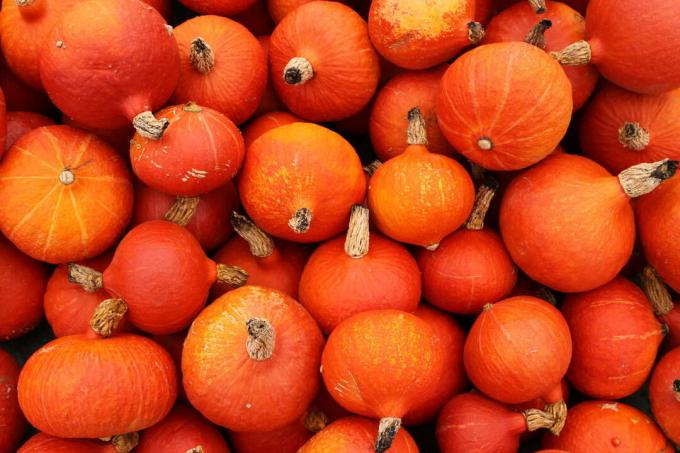
- Buttercup: Flattened, slightly angular fruits with dark green, hard skin; The flesh is bright orange, very creamy and has a slightly nutty aroma.
- Green Hokkaido: Small, flat-round variety with green skin and yellow-orange flesh.
- Solor: Comparable to 'Red Kuri', but smaller fruits; Type: Hokkaido.
- Golden Hubbard: Very firm, elongated fruits with many warts; The skin and pulp are bright orange in color; very good storable.
- Vert olive: Variety was bred in France before 1885; drop-shaped, olive-like fruits with smooth, dark green skin; firm pulp, known for its excellent taste.
- Gran Gigante: Winner variety of the largest edible pumpkin in the Guinness Book of Records; the peel of the round fruits is orange and ribbed; firm, yellow-orange pulp with a high water content.
- Yellow Pumpkin: Round giant pumpkin with smooth, pale orange skin and a weight of approx. 30 kg; yellow, firm pulp with a very high water content; ideal for pickling or for soups.
- Mini Hokkaido Zora: Compact growth ideal for cultivation in pots; The pulp has an excellent aroma.
- Jaune gros de Paris: Round giant pumpkin with smooth, pale yellow skin; particularly suitable for wet preservation and for insertion.
- Fictor: Pumpkin that looks very similar to the 'Solor' variety.
Ornamental pumpkin varieties: Poisonous varieties to decorate
In the case of ornamental pumpkins, it should always be noted that these pumpkin varieties are only suitable for decorative purposes and must not be consumed. All pumpkin varieties contain the poisonous bitter substance cucurbitacin and are therefore not edible. Nevertheless, the cultivation is worthwhile, as they enrich every garden with their colorful diversity and also spread an autumnal flair in the house. The following types of pumpkin are ideal for decorating.
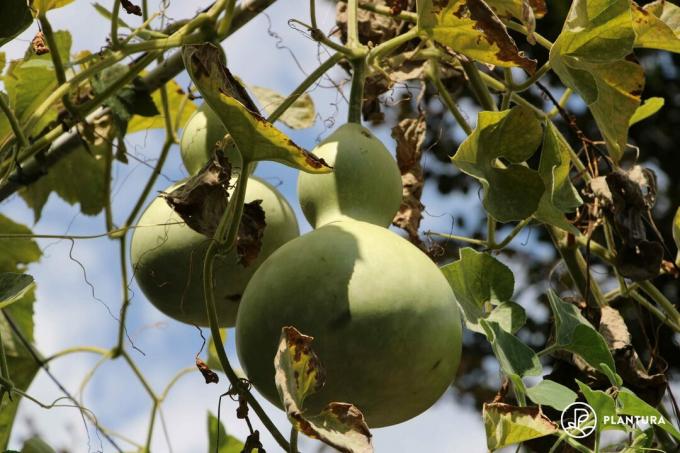
Ornamental pumpkin varieties: Cucurbita pepo
This type of pumpkin was cultivated in South America as early as 9,000 years ago. At that time, of course, the main interest was in cultivation as a useful and edible plant. In addition to the edible varieties already mentioned, there are now numerous ornamental pumpkin varieties of the species Cucurbita pepothat may not look good on the plate, but still look good on the table.
- Bicolor pear: Pear- and bottle-shaped pumpkins with stripes; half dark green, half bright yellow; very decorative.
- Wart mix: Some seed companies offer a mixture of different pumpkins with a very warty, uneven skin under this name.
- Turban mix: Mixture of turmeric pumpkins, which are particularly popular for decoration in autumn.
- Gooseneck: Deep yellow shining, uneven, warty skin; Pear-like shape with a curved neck.
- Speckled Swan: Variety belongs to the bottle gourd; Ornamental pumpkin from the tropics with dull green skin and decorative silvery spots; develops the characteristic curved gooseneck.
- Crown-shaped mixture: Mixture of claw-like and crown-like fruits in different, extremely decorative colors.
- Indian mix: Splendid mixture with small fruits in different shapes and colors; perfect for decorating.
- Autumn wings: Ornamental pumpkin mix with whimsical shaped fruits in eye-catching colors; perfect for autumn decoration.
- Pumpkin mix: Attractive decoration without carving with knives; Faces and figures can be easily painted on the smooth bowl of this mixture.
- Villa motley: Ornamental pumpkin mix of colorful and richly shaped varieties.
- Bottle gourd mix: Contains a variety of curious and bottle-shaped fruits.
Poisonous pumpkin varieties: varieties with dangerous bitter substances
Many of the colorful pumpkin varieties mentioned above are definitely not suitable for consumption. They contain dangerous bitter substances (cucurbitacins). You should also be careful with home-grown pumpkins from your own garden if you notice a bitter taste from your harvest. Through reverse mutations or crossings with wild varieties, the decisive genes for the bitter substances can reappear in the plant. In this case, there is no way you should eat the pumpkin. Consumption of fruits with a high content of bitter substances can lead to nausea, vomiting and intestinal problems. In principle, all common types of decorative pumpkin are not edible, but the following types are particularly poisonous.
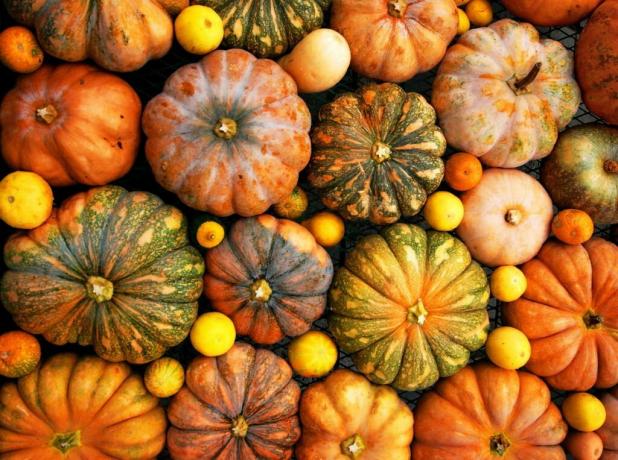
Poisonous pumpkin varieties:
- Bicolor pear
- Turban gourd
- Gooseneck
- Speckled Swan
- Lagenaria siceraria
More information about poisonous pumpkins can be found in our special article.
Edible varieties of pumpkin: varieties for cooking
Despite the danger of bitter substances, most types of pumpkin are actually edible and ideal for cooking. In principle, there is no danger from supermarket goods, which usually belong to the type of garden pumpkin. It is advisable to pay attention to the bitter taste of pumpkins from your own cultivation. At the slightest sign of bitter substances, we would always recommend not to eat the pumpkin and to spit out the bitter piece immediately for the sake of your health. To avoid crossing different types of pumpkin, it is advisable not to grow edible and ornamental pumpkins close together in the garden. So the dangerous bitter substances cannot be your undoing. You can cook and consume the following varieties without hesitation.

Edible pumpkin varieties:
- Hokkaido
- Butternut
- Uchiki Kuri
- Vegetable spaghetti
- Muscat de Provence
After choosing the right variety, that's what it's about Planting and caring for the pumpkins. You can find out what you should pay attention to in our article.



